234. Blue Korhaan Eupodotis caerulescens (Bloukorhaan )
Order: Otidiformes. Family: Otididae
Description
A fairly large bird growing to a total length of 50 to 58 cm.
The only korhaan with neck, breast and belly blue-grey, throat black and sides of face white. Both sexes have a dark cap but the ear coverts in the female are brownish, not white.
The forehead and crown are black, while the sides of the head are white. In males, the back, wings and tail are brown but the neck, throat, breast and belly are bluish-grey. Females are similar in colouring but the neck and underparts are a duller grey and the ear coverts are buff. The female has a brown cheek and the male a grey cheek. The legs and feet are yellow.
Behaviour
Move in pairs or family groups. Usually in groups of 3–5 birds. Roost in tight huddle on open ground or tall grass and returns to same roost every night, flying part of the way. When threatened they slink off head lowered or crouches down and hides.
Distribution
Endemic to southern Africa, occurring in the highveld of South Africa surrounding and extending into Lesotho.
Habitat
It generally prefers flat or undulating ground in grassland and Nama Karoo.
Diet
It mainly eats insects, lizards and plant matter, doing most of its foraging by walking along and pecking the ground, often in cultivated fields.
Breeding
Its breeding system is complex, as it can be either monogamous or polygamous, usually in trios with either two males or two females. However it may also breed cooperatively in groups of up to five, together raising a brood and defending the nest against predators. The nest is a simple scrape in the ground, usually between grass tufts tall enough to conceal the incubating bird. Egg-laying season is from September-February, peaking from October-November. It lays 1-2, rarely 3 eggs, which are solely incubated by a single female or multiple females (depending on the size of the family group) for about 24-28 days. The chicks are fed by both parents, leaving the nest soon after hatching to join the family group, who vigorously defend them by chasing away or distracting predators. The young take their first flight at about five weeks old.
Call
The call is a series of throaty krok-kau, often heard around dawn and uttered during flight.
Status
Locally common resident in grassland and e Karoo.
Near-threatened globally and regionally, although its population is decreasing, probably due to habitat loss caused by cultivation, human settlement and afforestation.
The population of this species was estimated to be between 8,000 and 10,000 mature birds in 2017 by the International Union for Conservation of Nature (IUCN). In the Eastern Karoo the population seems to be declining but elsewhere it seems fairly stable. However, according to the IUCN, the area of suitable habitat is being reduced due to grassland being converted for agricultural use, and this is expected to continue. For this reason, the IUCN has assessed the bird's conservation status as being "near threatened".
Africa Wild Bird Book
-
Klipspringer
- Global Moderator
- Posts: 5858
- Joined: Sat Sep 14, 2013 12:34 pm
- Country: Germany
- Contact:
-
Klipspringer
- Global Moderator
- Posts: 5858
- Joined: Sat Sep 14, 2013 12:34 pm
- Country: Germany
- Contact:
Blue Korhaan Photos
234. Blue Korhaan Eupodotis caerulescens
Mountain Zebra National Park © PJL
Links:
http://sabap2.birdmap.africa/docs/sabap1/234.pdf
https://www.iucnredlist.org/species/22692000/118449147
Mountain Zebra National Park © PJL
Links:
http://sabap2.birdmap.africa/docs/sabap1/234.pdf
https://www.iucnredlist.org/species/22692000/118449147
- Mel
- Global Moderator
- Posts: 26737
- Joined: Sat May 19, 2012 12:31 pm
- Country: Germany
- Location: Föhr
- Contact:
Karoo Korhaan
235. Karoo Korhaan Eupodotis vigorsii (Vaalkorhaan)
Order: Otidiformes. Family: Otididae
Description
It is a medium- to large-sized bird, about 60 cm long from tip to tail, standing about 25 cm high at the shoulder, with quite a long neck of about 14 cm. A grey-brown bustard with a black throat and black patch on the nape which is smaller in females. The plain face and black throat are characteristic. In flight, wings show a black-and-buff pattern.
Adult male: Head and neck plain grey-brown with paler moustachial stripe; nape with black patch. Remainder of upper parts, incl upper wing coverts, grey-brown, finely vermiculated dark brown. Remiges and primary coverts blackish brown, with creamy buff bases, forming pale panel in outer wing in flight. Underwing coverts creamy buff, with blackish-brown tips; secondaries mostly blackish, but large, creamy bases to primaries. Throat black, extending as narrow streak down foreneck; remainder of underparts plain grey-brown, paling slightly on belly. Bill dark horn, paler at base. Eyes greyish brown. Legs dull yellow.
Adult female: As male, but throat patch less extensive, lacking black stripe on foreneck. Mantle, scapulars and wing coverts more heavily marked, with blackish blotches.
Juvenile resembles female.
Similar species: lt resembles Rüppell's Korhaan, but lacks the facial markings and is darker on the back. Rüppell's Korhaan is whiter below, paler above, and has a blue-grey neck.
Taxonomy
There are two subspecies:
E. v. namaqua - Arid s Namibia and Northern Cape Province
E. v. vigorsii - Free State Province to Western Cape Province (South Africa).
In Bushmanland, both sub-species occur together: Eupodotis vigorsii vigorsii, which is a darker brown; and E. v. namaqua, which is a much paler, sandy colour.
Distribution
Lesotho, southern Namibia and South Africa. The Karoo Korhaan is endemic to southern Africa, with the largest numbers found in the shrubland of the Nama Karoo (lower concentrations in the Succulent Karoo, and absent from grasslands and the coastal areas of Namaqualand). The bird’s range extends from the Fish River in the Eastern Cape, the western Free State, through the Karoo to the southern half of Namibia. To the south it also occurs in cultivated fields on the Agulhas Plain.

Habitat
Mainly stony Karoo shrubland. It generally prefers dwarf arid shrubland of the Nama Karoo and succulent Karoo, especially with stony ground, while in the Western Cape it also occurs in cultivated land.
Diet
Invertebrates, reptiles, grass and seeds.
Breeding
Monogamous, often breeding in family groups with a breeding pair and other helpers, who help to defend the territory. The nest is a shallow scrape in the scrape in the ground, usually among scattered shrubs and rocks. Egg-laying season is from June-February, peaking from December-January. It lays a single egg, which is incubated solely by the female, who sometimes temporarily leaves the nest to go foraging with the male.
Call
Frog-like kraak-rak or krok-rak-rak at dusk and dawn. Listen to Bird Call.
Status
Common, endemic resident.
Order: Otidiformes. Family: Otididae
Description
It is a medium- to large-sized bird, about 60 cm long from tip to tail, standing about 25 cm high at the shoulder, with quite a long neck of about 14 cm. A grey-brown bustard with a black throat and black patch on the nape which is smaller in females. The plain face and black throat are characteristic. In flight, wings show a black-and-buff pattern.
Adult male: Head and neck plain grey-brown with paler moustachial stripe; nape with black patch. Remainder of upper parts, incl upper wing coverts, grey-brown, finely vermiculated dark brown. Remiges and primary coverts blackish brown, with creamy buff bases, forming pale panel in outer wing in flight. Underwing coverts creamy buff, with blackish-brown tips; secondaries mostly blackish, but large, creamy bases to primaries. Throat black, extending as narrow streak down foreneck; remainder of underparts plain grey-brown, paling slightly on belly. Bill dark horn, paler at base. Eyes greyish brown. Legs dull yellow.
Adult female: As male, but throat patch less extensive, lacking black stripe on foreneck. Mantle, scapulars and wing coverts more heavily marked, with blackish blotches.
Juvenile resembles female.
Similar species: lt resembles Rüppell's Korhaan, but lacks the facial markings and is darker on the back. Rüppell's Korhaan is whiter below, paler above, and has a blue-grey neck.
Taxonomy
There are two subspecies:
E. v. namaqua - Arid s Namibia and Northern Cape Province
E. v. vigorsii - Free State Province to Western Cape Province (South Africa).
In Bushmanland, both sub-species occur together: Eupodotis vigorsii vigorsii, which is a darker brown; and E. v. namaqua, which is a much paler, sandy colour.
Distribution
Lesotho, southern Namibia and South Africa. The Karoo Korhaan is endemic to southern Africa, with the largest numbers found in the shrubland of the Nama Karoo (lower concentrations in the Succulent Karoo, and absent from grasslands and the coastal areas of Namaqualand). The bird’s range extends from the Fish River in the Eastern Cape, the western Free State, through the Karoo to the southern half of Namibia. To the south it also occurs in cultivated fields on the Agulhas Plain.

Habitat
Mainly stony Karoo shrubland. It generally prefers dwarf arid shrubland of the Nama Karoo and succulent Karoo, especially with stony ground, while in the Western Cape it also occurs in cultivated land.
Diet
Invertebrates, reptiles, grass and seeds.
Breeding
Monogamous, often breeding in family groups with a breeding pair and other helpers, who help to defend the territory. The nest is a shallow scrape in the scrape in the ground, usually among scattered shrubs and rocks. Egg-laying season is from June-February, peaking from December-January. It lays a single egg, which is incubated solely by the female, who sometimes temporarily leaves the nest to go foraging with the male.
Call
Frog-like kraak-rak or krok-rak-rak at dusk and dawn. Listen to Bird Call.
Status
Common, endemic resident.
God put me on earth to accomplish a certain amount of things. Right now I'm so far behind that I'll never die.
- Mel
- Global Moderator
- Posts: 26737
- Joined: Sat May 19, 2012 12:31 pm
- Country: Germany
- Location: Föhr
- Contact:
Karoo Korhaan Photos
235. Karoo Korhaan Eupodotis vigorsii (Vaalkorhaan)
 © Mel
© Mel
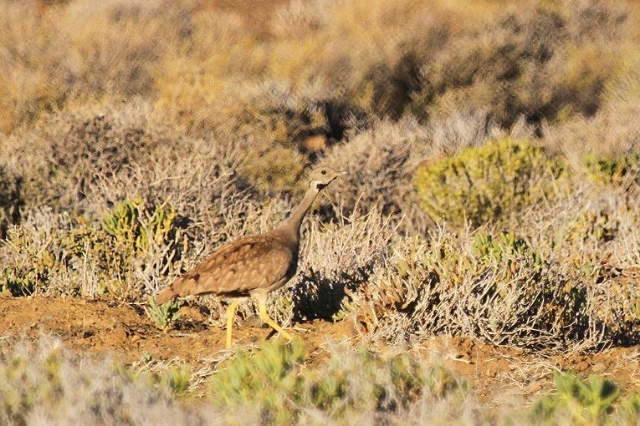 © leachy
© leachy
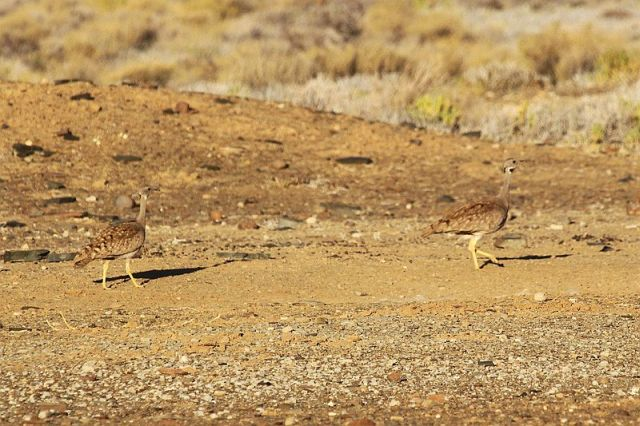 © leachy
© leachy
Tankwa Karoo National Park
Links:
Species text in The Atlas of Southern African Birds
Sabap2
NEWMAN'S VOELS VAN SA (8ste UIT)
 © Mel
© Mel © leachy
© leachy © leachy
© leachyTankwa Karoo National Park
Links:
Species text in The Atlas of Southern African Birds
Sabap2
NEWMAN'S VOELS VAN SA (8ste UIT)
God put me on earth to accomplish a certain amount of things. Right now I'm so far behind that I'll never die.
Rüppell's Korhaan
236. Rüppell's Korhaan Eupodotis rueppellii (Woestynkorhaan)
Order: Otidiformes. Family: Otididae
Description
Medium-sized bustard. Size 55-60 cm. Weight 1.2 kg. Grey head and neck, black stripes down the throat (less marked in females), through the eye, and on the sides of the neck, and white cheeks. The body is sandy brown above, and pale below. The legs are sandy yellow-brown.
Male: More baldly marked on head and throat. Dark eyes.
Female: Dark markings on upperparts, reduced black and white patterns on the hindneck. Pale eyes.
Juveniles resemble females.
Similar species: Told from Karoo Korhaan by paler almost pinkish plumage on the back, by black line running down the centre of the foreneck onto the breast and by contrasting black and white facial markings.
Distribution
Near endemic to western Namibia (Namib Desert, Namib-Naukluft Park and the Skeleton Coast), marginally extending into south-western Angola.
Habitat
Limited in distribution to the dry, sandy and gravel plains of the Namib Desert in the west of Namibia, where the vegetation is sparse scrub desert. They are often seen along the sides of the quiet gravel roads in the Namib-Naukluft National Park, or along the Skeleton Coast in Namibia.
Diet
Pecks at invertebrates on the ground as they walk including termites, small reptiles and vegetable matter such as seeds and succulent leaves. An occasional drinker.
Breeding
Monogamous, sometimes breeding in pairs or large family groups. The nest is a shallow scrape in the ground among rocks and stones, occasionally with plant cover. Egg-laying season is year-round, peaking from February-May. Between 1 and 3 cream or buff eggs are laid directly on the rocky ground, eggs are incubated solely by the female.
Call
Their call is a deep, frog-like croak, usually taking the form of a duet: waaa-a-re-e, waaa-a-re-e first sound by the male, next three by the female, repeated in long sequences Listen to Bird Call.
Status
Common resident.
Order: Otidiformes. Family: Otididae
Description
Medium-sized bustard. Size 55-60 cm. Weight 1.2 kg. Grey head and neck, black stripes down the throat (less marked in females), through the eye, and on the sides of the neck, and white cheeks. The body is sandy brown above, and pale below. The legs are sandy yellow-brown.
Male: More baldly marked on head and throat. Dark eyes.
Female: Dark markings on upperparts, reduced black and white patterns on the hindneck. Pale eyes.
Juveniles resemble females.
Similar species: Told from Karoo Korhaan by paler almost pinkish plumage on the back, by black line running down the centre of the foreneck onto the breast and by contrasting black and white facial markings.
Distribution
Near endemic to western Namibia (Namib Desert, Namib-Naukluft Park and the Skeleton Coast), marginally extending into south-western Angola.
Habitat
Limited in distribution to the dry, sandy and gravel plains of the Namib Desert in the west of Namibia, where the vegetation is sparse scrub desert. They are often seen along the sides of the quiet gravel roads in the Namib-Naukluft National Park, or along the Skeleton Coast in Namibia.
Diet
Pecks at invertebrates on the ground as they walk including termites, small reptiles and vegetable matter such as seeds and succulent leaves. An occasional drinker.
Breeding
Monogamous, sometimes breeding in pairs or large family groups. The nest is a shallow scrape in the ground among rocks and stones, occasionally with plant cover. Egg-laying season is year-round, peaking from February-May. Between 1 and 3 cream or buff eggs are laid directly on the rocky ground, eggs are incubated solely by the female.
Call
Their call is a deep, frog-like croak, usually taking the form of a duet: waaa-a-re-e, waaa-a-re-e first sound by the male, next three by the female, repeated in long sequences Listen to Bird Call.
Status
Common resident.
Rüppell's Korhaan Photos
236. Rüppell's Korhaan (previously known as Ruppell’s bustard) Eupodotis rueppellii
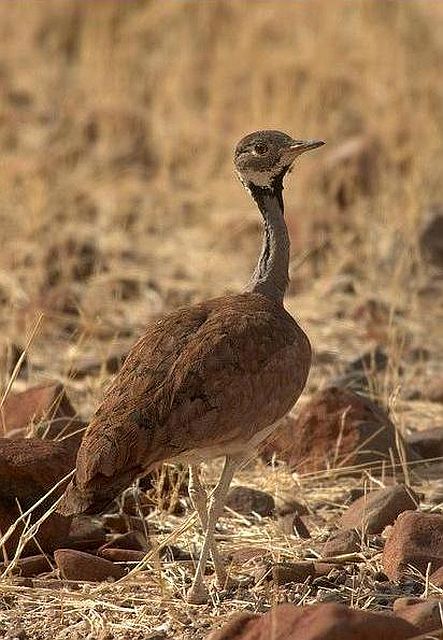
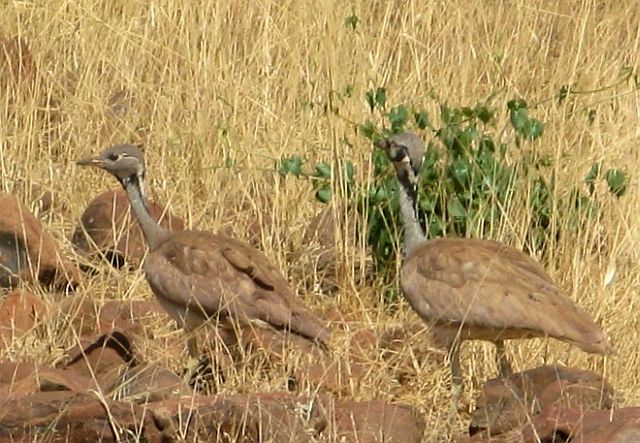
Links:
Species text in The Atlas of Southern African Birds
Sabap2
NEWMAN'S VOELS VAN SA (8ste UIT)


Links:
Species text in The Atlas of Southern African Birds
Sabap2
NEWMAN'S VOELS VAN SA (8ste UIT)
Red-crested Korhaan
237. Red-crested Korhaan Eupodotis ruficrista (Boskorhaan)
Order: Otidiformes. Family: Otitidae
Description
Length 50 cm, weight 300-910 g; average mass of males (682 g) slightly higher than that of females (667 g).
Adult male: The crown is grey and the crest (which is concealed unless displaying) is rufous. Upperparts are brown; feathers have black centres and white chevron marks (not barring). The foreneck is grey. The underparts are black except for white patches on each side of the upper breast. The eyes are pale, the bill dark horn and the legs and feet are off-white to grey-green. Olive (not yellow) legs. In flight, it shows an all blaqck belly and underwings.
Adult female: Similar to the male, but the crown is brown with white flecks, and the neck and upper breast are buff with black flecks, grading to a broad white breast band.
Juvenile resembles the female, but with buff tips to flight feathers.
Similar species: Told from other small korhaans by creamy- white V marks on the upperparts; has shorter legs and shorter neck than Black-bellied Korhaan.
The female Northern Black Korhaan lacks the white chevrons (not barring) on the upperparts and has less black on the belly. The Black-bellied Bustard also lacks the white chevrons on the upperparts; the male has a black stripe down the foreneck and the female has a white belly. Separated from male Black-bellied Bustard also by greyish (not brownish) crown and buff (not white) cheeks.
Distribution
Near-endemic to southern Africa, occurring from southern Angola and Zambia to Namibia, Botswana, Zimbabwe, southern Mozambique, Northern Cape and north-eastern South Africa.
Habitat
It is the most woodland-dependent of the bustards and korhaans, occurring in Mopane (Colospermum mopane), Acacia, cluster-leaf (Terminalia), Zambezi teak (Baikiaea plurijaga) and miombo (Brachystegia) woodland.
Diet
It eats mainly invertebrates such as termites and beetles, supplemented with seeds and fruit. It mainly forages on the ground, picking up food items with its bill.
Breeding
Polygynous, with each male performing an elaborate courtship display to multiple females, some of which he will mate with. It lays its eggs directly on the ground, often among dense leaf-litter. Egg-laying season is from September-April, peaking from October-February. It lays 1-2 eggs, which are incubated solely by the female for about 22 days. Young fledge at roughly six weeks old.
Call
Loud piercing chew-chew-chew. Main call by the male is a series of clicks followed by ventriloquial kyip-kyip-kyip notes.
Listen to Bird Call: http://www.xeno-canto.org/species/Lophotis-ruficrista
Status
Common, near-endemic resident, sedentary and usually found singly.
Order: Otidiformes. Family: Otitidae
Description
Length 50 cm, weight 300-910 g; average mass of males (682 g) slightly higher than that of females (667 g).
Adult male: The crown is grey and the crest (which is concealed unless displaying) is rufous. Upperparts are brown; feathers have black centres and white chevron marks (not barring). The foreneck is grey. The underparts are black except for white patches on each side of the upper breast. The eyes are pale, the bill dark horn and the legs and feet are off-white to grey-green. Olive (not yellow) legs. In flight, it shows an all blaqck belly and underwings.
Adult female: Similar to the male, but the crown is brown with white flecks, and the neck and upper breast are buff with black flecks, grading to a broad white breast band.
Juvenile resembles the female, but with buff tips to flight feathers.
Similar species: Told from other small korhaans by creamy- white V marks on the upperparts; has shorter legs and shorter neck than Black-bellied Korhaan.
The female Northern Black Korhaan lacks the white chevrons (not barring) on the upperparts and has less black on the belly. The Black-bellied Bustard also lacks the white chevrons on the upperparts; the male has a black stripe down the foreneck and the female has a white belly. Separated from male Black-bellied Bustard also by greyish (not brownish) crown and buff (not white) cheeks.
Distribution
Near-endemic to southern Africa, occurring from southern Angola and Zambia to Namibia, Botswana, Zimbabwe, southern Mozambique, Northern Cape and north-eastern South Africa.
Habitat
It is the most woodland-dependent of the bustards and korhaans, occurring in Mopane (Colospermum mopane), Acacia, cluster-leaf (Terminalia), Zambezi teak (Baikiaea plurijaga) and miombo (Brachystegia) woodland.
Diet
It eats mainly invertebrates such as termites and beetles, supplemented with seeds and fruit. It mainly forages on the ground, picking up food items with its bill.
Breeding
Polygynous, with each male performing an elaborate courtship display to multiple females, some of which he will mate with. It lays its eggs directly on the ground, often among dense leaf-litter. Egg-laying season is from September-April, peaking from October-February. It lays 1-2 eggs, which are incubated solely by the female for about 22 days. Young fledge at roughly six weeks old.
Call
Loud piercing chew-chew-chew. Main call by the male is a series of clicks followed by ventriloquial kyip-kyip-kyip notes.
Listen to Bird Call: http://www.xeno-canto.org/species/Lophotis-ruficrista
Status
Common, near-endemic resident, sedentary and usually found singly.
Red-crested Korhaan Photos
237. Red-crested Korhaan Eupodotis ruficrista
 © Toko
© Toko
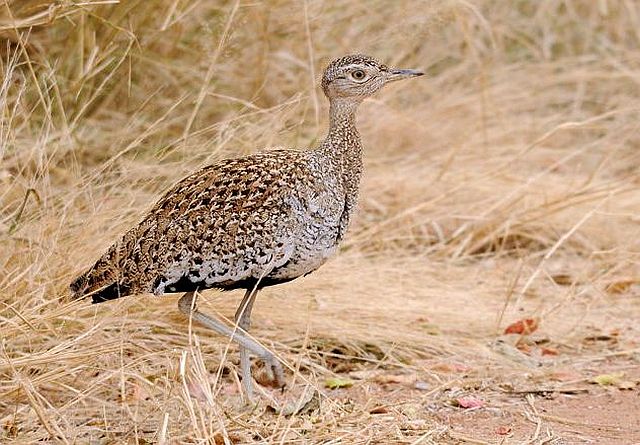 © Dewi
© Dewi
Female
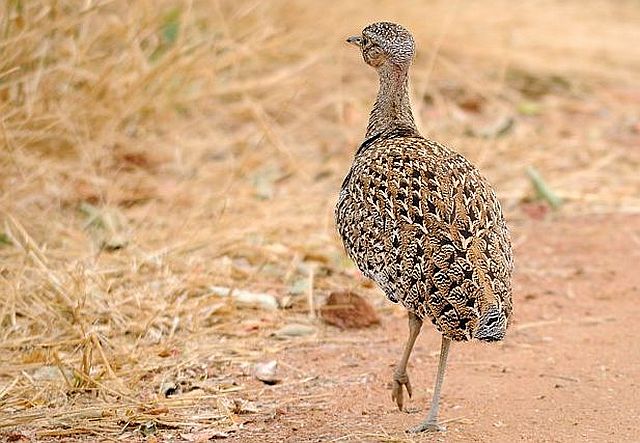 © Dewi
© Dewi
Female
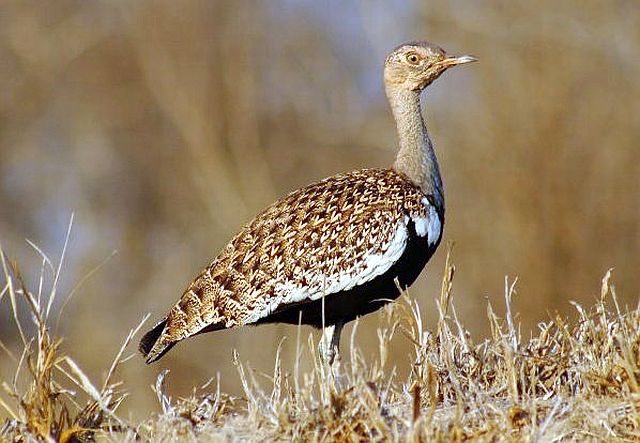 © Flutterby
© Flutterby
Male
 © Amoli
© Amoli
Male
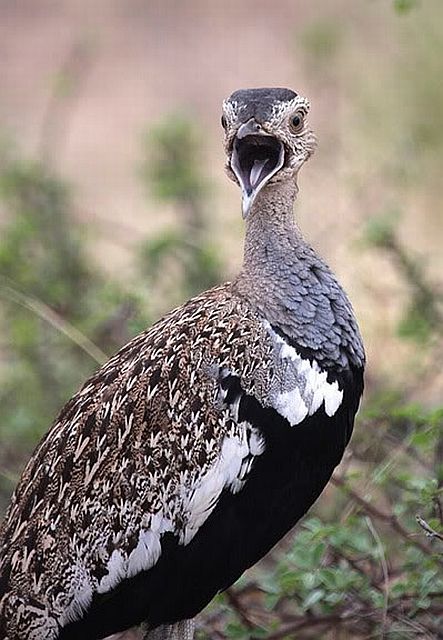 © leachy
© leachy
 © Heksie
© Heksie
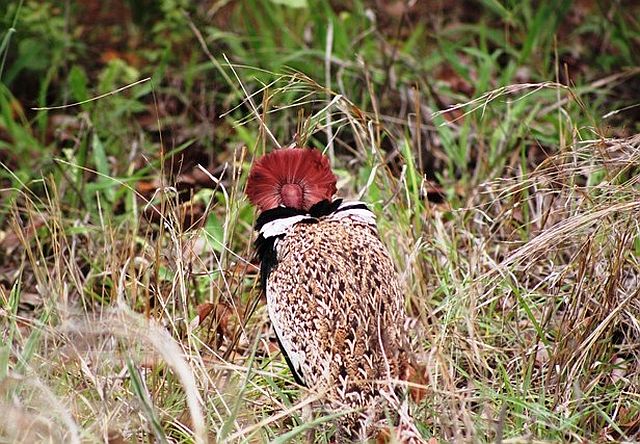 © Heksie
© Heksie
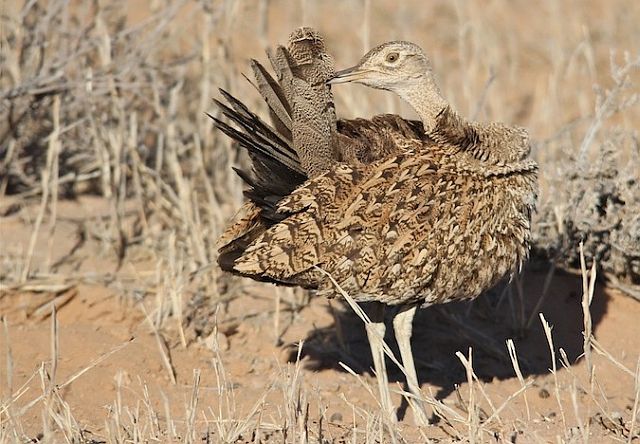 © ExFmem
© ExFmem
Links:
http://sabap2.adu.org.za/docs/sabap1/237.pdf
http://sabap2.adu.org.za/spp_summary.ph ... §ion=3
 © Toko
© Toko © Dewi
© DewiFemale
 © Dewi
© DewiFemale
 © Flutterby
© FlutterbyMale
 © Amoli
© AmoliMale
 © leachy
© leachy © Heksie
© Heksie © Heksie
© Heksie © ExFmem
© ExFmemLinks:
http://sabap2.adu.org.za/docs/sabap1/237.pdf
http://sabap2.adu.org.za/spp_summary.ph ... §ion=3
Southern Black Korhaan
239a. Southern Black Korhaan Afrotis afra (Eupodotis afra) (Swartvlerkkorhaan)
Order: Otidiformes. Family: Otitidae
Description
The Southern Black Korhaan has a height of 50-53 cm and weighs around 700 g.
The male is predominantly black and white, with the neck being coal black and the back being white, with black flecks like a pattern. The area near the ear patch is white and the beak is red with a black tip. The legs are yellow. The female is a light shade of brown with white flecks like a pattern. The neck is long and the eyes are a light brown. The legs are yellow.
Similar species: On the ground indistinguishable from Northern Black Korhaan, to which it is closely related, but in flight from above both sexes differ in having entirely black primary wing feathers (the Northern has white inner-webs to its primaries). The male is unmistakable; female told from other female korhaans by pink bill with a pale tip.
Distribution
Endemic to South Africa, occurring in the Western Cape, marginally extending into the Eastern and Northern Cape. The range is along the west and south coasts from Little Namaqualand south to Cape Town and then east to Grahamstown. Common in West Coast National Park and Addo Elephant National Park.
Habitat
It is common to uncommon in the remnants of renosterveld, as well as strandveld and Nama karoo. It inhabits the shrublands of the fynbos and Karoo biomes in areas where grass or tree cover are virtually absent.
Diet
It eats mainly insects, small reptiles and plant material, foraging on the ground and picking up food items with its bill.
Breeding
Polygynous, meaning that one male mates with multiple females. It does not use a nest, instead laying its eggs directly on the ground, typically in an area that conceals the incubating female. Egg-laying season is from August-January, peaking from September-October. It lays one, rarely two eggs, which are incubated solely by the female. The chicks are are cared for by the female only.
Call
Harsh, raucous krr-ack, krr-ack and similat notes. Listen to Bird Call.
Status
Locally common endemic. This species listed as Vulnerable on the IUCN Red List, it has been uplisted from Least Concern to Vulnerable as it is suspected to be undergoing rapid population declines owing to the loss and fragmentation of its habitat to agricultural conversion.
Order: Otidiformes. Family: Otitidae
Description
The Southern Black Korhaan has a height of 50-53 cm and weighs around 700 g.
The male is predominantly black and white, with the neck being coal black and the back being white, with black flecks like a pattern. The area near the ear patch is white and the beak is red with a black tip. The legs are yellow. The female is a light shade of brown with white flecks like a pattern. The neck is long and the eyes are a light brown. The legs are yellow.
Similar species: On the ground indistinguishable from Northern Black Korhaan, to which it is closely related, but in flight from above both sexes differ in having entirely black primary wing feathers (the Northern has white inner-webs to its primaries). The male is unmistakable; female told from other female korhaans by pink bill with a pale tip.
Distribution
Endemic to South Africa, occurring in the Western Cape, marginally extending into the Eastern and Northern Cape. The range is along the west and south coasts from Little Namaqualand south to Cape Town and then east to Grahamstown. Common in West Coast National Park and Addo Elephant National Park.
Habitat
It is common to uncommon in the remnants of renosterveld, as well as strandveld and Nama karoo. It inhabits the shrublands of the fynbos and Karoo biomes in areas where grass or tree cover are virtually absent.
Diet
It eats mainly insects, small reptiles and plant material, foraging on the ground and picking up food items with its bill.
Breeding
Polygynous, meaning that one male mates with multiple females. It does not use a nest, instead laying its eggs directly on the ground, typically in an area that conceals the incubating female. Egg-laying season is from August-January, peaking from September-October. It lays one, rarely two eggs, which are incubated solely by the female. The chicks are are cared for by the female only.
Call
Harsh, raucous krr-ack, krr-ack and similat notes. Listen to Bird Call.
Status
Locally common endemic. This species listed as Vulnerable on the IUCN Red List, it has been uplisted from Least Concern to Vulnerable as it is suspected to be undergoing rapid population declines owing to the loss and fragmentation of its habitat to agricultural conversion.
Southern Black Korhaan Photos
239a. Southern Black Korhaan Afrotis afra (Eupodotis afra)
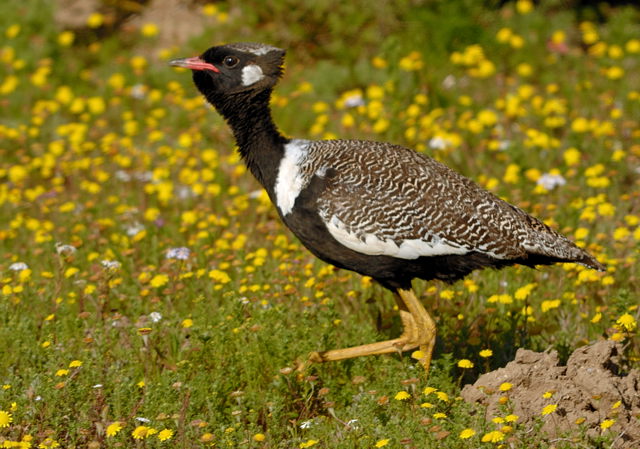 © Dewi
© Dewi
Male
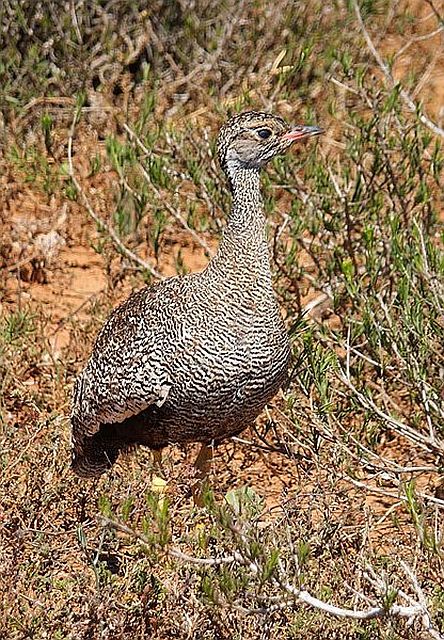 Female © PJL
Female © PJL
Addo Elephant National Park
Links:
Species text in The Atlas of Southern African Birds: http://sabap2.adu.org.za/docs/sabap1/239.pdf
Sabap2
Avian Leisure: SOUTH AFRICA’S CONFUSING BIRD SPECIES: BLACK KORHAANS
 © Dewi
© Dewi Male
 Female © PJL
Female © PJLAddo Elephant National Park
Links:
Species text in The Atlas of Southern African Birds: http://sabap2.adu.org.za/docs/sabap1/239.pdf
Sabap2
Avian Leisure: SOUTH AFRICA’S CONFUSING BIRD SPECIES: BLACK KORHAANS


